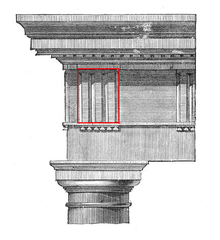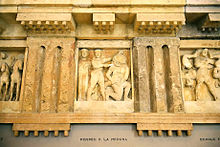Triglyph


The triglyph (also the triglyph , ancient Greek τρίγλυφος 'three grooves / notches' ) is a plate on the frieze of the Doric order with two full inner and two half outer grooves (without these also called diglyph ) between the metopes , with which together they form the triglyph frieze form.
In the past, the general view in science was that the triglyph was derived from a carved ornament or a special wood connection of the transverse architraves that span the columns with the longitudinal purlins of the roof truss in the originally wooden entablature of Greek temples . In the meantime, the assumption has also been made that the triglyph frieze had a purely ornamental character and cannot be derived from the wooden construction of archaic temples. Examples of triglyphs, which were worked as protruding reliefs with tripods, sacrificial bowls or the like instead of slits, for example on the Small Propylaea of Eleusis or on a workpiece on Samos , show that the constructive connection was no longer assumed or understood in late Hellenism .
With the advent of stone temple architecture, a problem arose in the proportions of the Doric order , which is called the Doric corner conflict . The triglyph plays a crucial role here. Since the uniform rhythm of the design elements required that a triglyph always had to be attached above the column axis of the corresponding column, a conflict arose at the corner triglyph. Because the triglyphs of the stone building are much narrower than the deep architrave, which is also centrally located above the column axis. In order to be 'flush' with the architrave edge at the corner, the trigyle had to be pushed out of the column axis towards the corner of the building, which disturbed the uniform overall impression. Incidentally, this conflict must have already arisen in the late wooden buildings, as it can also be proven at the Heraion in Olympia . Its wooden pillars were only gradually replaced by stone pillars, but its wooden beams already showed the corner conflict.
The triglyph frieze can also be found as an ornament in classicism and historicism . Its forerunners could be found in the area of Near Eastern architecture. Two portable temple models decorated with triglyphs were found in the ruins of Khirbet Qeiyafa . One is 20 centimeters, the other 35 centimeters high. They are used as models of the biblical Jerusalem temple from the time of David around 1000 BC. Interpreted.
Triglyphs of the stoa of the Acropolis of Lindos
literature
- Norbert Weickenmeier: Theories on the genesis of the triglyphone. Attempt to take a critical inventory. Darmstadt 1985 (Darmstadt, Technical University, dissertation, 1985).
- Ernst-Ludwig Schwandner : The older Poro temple of Aphaia on Aegina (= monuments of ancient architecture. Vol. 16). de Gruyter, Berlin 1985, ISBN 3-11-010279-X , p. 117 ff.
- Dieter Mertens : The old temple of Hera in Paestum and the archaic architecture in southern Italy (= German Archaeological Institute. Rome department. Special publications. Vol. 9). von Zabern, Mainz 1993, ISBN 3-8053-1331-4 , p. 103 ff.
Web links
Individual evidence
- ^ Vitruv: Ten books on architecture. IV. Book, chap. 2, paragraph 2 and Cape. 3, paragraph 1 f.
- ^ So: Hermann Kienast: To the Doric triglyph frieze. In: Athenian communications. Vol. 117, ISSN 0342-1325 , 2002, pp. 53-68.
- ↑ Hans Lauter : The architecture of Hellenism. Wissenschaftliche Buchgesellschaft, Darmstadt 1986, ISBN 3-534-09401-8 , p. 263, Fig. 71b, plate 40b.
- ^ Wolfgang Müller-Wiener : Greek construction in antiquity. Beck, Munich 1988, ISBN 3-406-32993-4 , p. 113.
- ↑ And yet there was a great empire of David. No picture, no pig , WeltN24 GmbH. May 9, 2012. Retrieved November 8, 2015.


